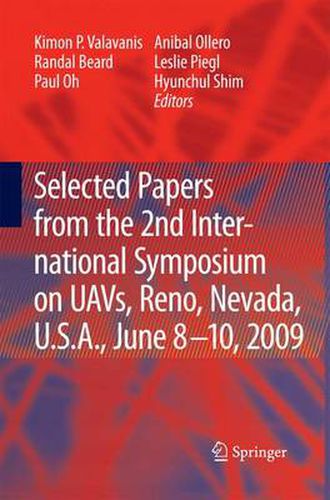Selected papers from the 2nd International Symposium on UAVs, Reno, U.S.A. June 8-10, 2009

Selected papers from the 2nd International Symposium on UAVs, Reno, U.S.A. June 8-10, 2009
This title is printed to order. This book may have been self-published. If so, we cannot guarantee the quality of the content. In the main most books will have gone through the editing process however some may not. We therefore suggest that you be aware of this before ordering this book. If in doubt check either the author or publisher’s details as we are unable to accept any returns unless they are faulty. Please contact us if you have any questions.
In the last decade, signi?cant changes have occurred in the ?eld of vehicle motion planning, and for UAVs in particular. UAV motion planning is especially dif?cult due to several complexities not considered by earlier planning strategies: the - creased importance of differential constraints, atmospheric turbulence which makes it impossible to follow a pre-computed plan precisely, uncertainty in the vehicle state, and limited knowledge about the environment due to limited sensor capabilities. These differences have motivated the increased use of feedback and other control engineering techniques for motion planning. The lack of exact algorithms for these problems and dif?culty inherent in characterizing approximation algorithms makes it impractical to determine algorithm time complexity, completeness, and even soundness. This gap has not yet been addressed by statistical characterization of experimental performance of algorithms and benchmarking. Because of this overall lack of knowledge, it is dif?cult to design a guidance system, let alone choose the algorithm. Throughout this paper we keep in mind some of the general characteristics and requirements pertaining to UAVs. A UAV is typically modeled as having velocity and acceleration constraints (and potentially the higher-order differential constraints associated with the equations of motion), and the objective is to guide the vehicle towards a goal through an obstacle ?eld. A UAV guidance problem is typically characterized by a three-dimensional problem space, limited information about the environment, on-board sensors with limited range, speed and acceleration constraints, and uncertainty in vehicle state and sensor data.
This item is not currently in-stock. It can be ordered online and is expected to ship in 7-14 days
Our stock data is updated periodically, and availability may change throughout the day for in-demand items. Please call the relevant shop for the most current stock information. Prices are subject to change without notice.
Sign in or become a Readings Member to add this title to a wishlist.


